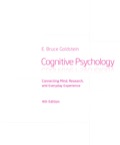
Introduction
Memories are dynamic; with time, humans forget many details of what they have learned or experienced. Donald Hebb proposed that the physiological changes that happen at the synapses and the gaps between one neuron's end and the other's dendrite or cell body represent memory and learning in the brain.
Explanation of Solution
Answer and explanation
In their experiment on immediate and delayed recall, Muller and Pilzecker (1900) found that participants in the delayed group were able to recall more information than those in the immediate recall group. On the basis of this research, they proposed the concept of consolidation, which they defined as the process that converts fragile, new memories into a more permanent state. When these changes occur at synapses, it is known as synaptic consolidation.
Hebb proposed that, in the brain, memories are represented as the physiological changes that occur at the synapses. He further proposed that repeated activity at these synapses can strengthen them, along with strengthening the memory, by changing the structure of the synapse and increasing the release of neurotransmitters. Studies by Chokovski and colleagues (2004) and Kida and coworkers (2002) support the idea that activity at the synapse causes the release of certain chemicals which further lead to structural changes at the synapse, which strengthens synaptic transmission. This strengthening leads to enhanced firing of neurons because of repeated activity and is known as long-term potentiation. Thus, these results indicate that memories are represented at the synapses, and experience and learning lead to changes at the synapse.
Want to see more full solutions like this?
Chapter 7 Solutions
EBK COGNITIVE PSYCHOLOGY: CONNECTING MI
- Hi with this unit/ assessment PSY4406 TP4 Report assessment material case stydu Ms Alecia Moore. in the Assessment tool 2 - Trait emotional intelliegence can you provied the results for the test, and the test results for Assessment 3 - Mini International personality item pool. https://www.bartleby.com/docs/psychology/4369920 thanl you, your response is greatly appricatedarrow_forwardWhat are the expectations going into the internship with high school student beahavoir?arrow_forwardWrite a 1,200-1,500-word analysis that describes the characteristics and roles you hope to embody as a counselor and the counselor dispositions that you want to bring with you. You may write in the first person for this assignment. Include the following in your analysis: Your role as a clinical mental health counselor or school counselor in the agency, school, and/or community you serve. Include strategies for collaborating and consulting with behavioral health care professionals. Refer to the importance of certification and licensure related to your role and professional identity. Strategies to develop a counselor identity that fosters leadership, advocacy and provides services as a licensed professional counselor or school counselor for persons with mental health issues. Depending on your program of study, refer to the GCU "SC Professional Dispositions of Learners" or the GCU "Counselor Dispositions" located in the Class Resources when completing this assignment. Consider your…arrow_forward
- what makes yoruba different from other religions or culturesarrow_forwardWhat does the PIC/NIC Analysis focus on from the Performer's Perspective? Consequences Antecedents Behavior X Behavior Yarrow_forwardWhat does the PIC/NIC Analysis focus on from the Performer's Perspective? Consequences Antecedents Behavior X Behavior Yarrow_forward
- The Performance Diagnostic Checklist-Human Services (PDC-HS) is an assessment tool to identify areas of improvement for employee performance within a work environment. For this task, you can complete the PDC-HS as a self-assessment within your work requirements or you can interview a colleague. Describe the performance concernarrow_forwardWhat are three methods for dissemination of information that school counselors can use after watching the YouTube video titled: “Self-care for school counselors” (https://www.youtube.com/watch?v=hvQyjEh1Lmk) by CSCA Executive Director (2020, April 2)? Please write in a narrative format and include citations and references.arrow_forwardWhat are the three most relevant principles school counselors need to be aware of watching the YouTube video titled: “Self-care for school counselors” (https://www.youtube.com/watch?v=hvQyjEh1Lmk) by CSCA Executive Director (2020, April 2))? Please write in a narrative format and include citations and references.arrow_forward
- What are three interventions or programs school counselors can implement in schools after watching the YouTube video titled: “Self-care for school counselors” (https://www.youtube.com/watch?v=hvQyjEh1Lmk) by CSCA Executive Director (2020, April 2))? Please write in a narrative format and include citations and references.arrow_forwardWhat are three professional best practices that school counselors can implement or can recommend in schools after watching the YouTube video titled: “Self-care for school counselors” (https://www.youtube.com/watch?v=hvQyjEh1Lmk) by CSCA Executive Director (2020, April 2))? Please write in a narrative format and include citations and references.arrow_forwardWhat are three strategies school counselors use in schools after watching the YouTube video titled: “Self-care for school counselors” (https://www.youtube.com/watch?v=hvQyjEh1Lmk) by CSCA Executive Director (2020, April 2)? Please write in a narrative format and include citations and references.arrow_forward
 Ciccarelli: Psychology_5 (5th Edition)PsychologyISBN:9780134477961Author:Saundra K. Ciccarelli, J. Noland WhitePublisher:PEARSON
Ciccarelli: Psychology_5 (5th Edition)PsychologyISBN:9780134477961Author:Saundra K. Ciccarelli, J. Noland WhitePublisher:PEARSON Cognitive PsychologyPsychologyISBN:9781337408271Author:Goldstein, E. Bruce.Publisher:Cengage Learning,
Cognitive PsychologyPsychologyISBN:9781337408271Author:Goldstein, E. Bruce.Publisher:Cengage Learning, Introduction to Psychology: Gateways to Mind and ...PsychologyISBN:9781337565691Author:Dennis Coon, John O. Mitterer, Tanya S. MartiniPublisher:Cengage Learning
Introduction to Psychology: Gateways to Mind and ...PsychologyISBN:9781337565691Author:Dennis Coon, John O. Mitterer, Tanya S. MartiniPublisher:Cengage Learning Psychology in Your Life (Second Edition)PsychologyISBN:9780393265156Author:Sarah Grison, Michael GazzanigaPublisher:W. W. Norton & Company
Psychology in Your Life (Second Edition)PsychologyISBN:9780393265156Author:Sarah Grison, Michael GazzanigaPublisher:W. W. Norton & Company Cognitive Psychology: Connecting Mind, Research a...PsychologyISBN:9781285763880Author:E. Bruce GoldsteinPublisher:Cengage Learning
Cognitive Psychology: Connecting Mind, Research a...PsychologyISBN:9781285763880Author:E. Bruce GoldsteinPublisher:Cengage Learning Theories of Personality (MindTap Course List)PsychologyISBN:9781305652958Author:Duane P. Schultz, Sydney Ellen SchultzPublisher:Cengage Learning
Theories of Personality (MindTap Course List)PsychologyISBN:9781305652958Author:Duane P. Schultz, Sydney Ellen SchultzPublisher:Cengage Learning





